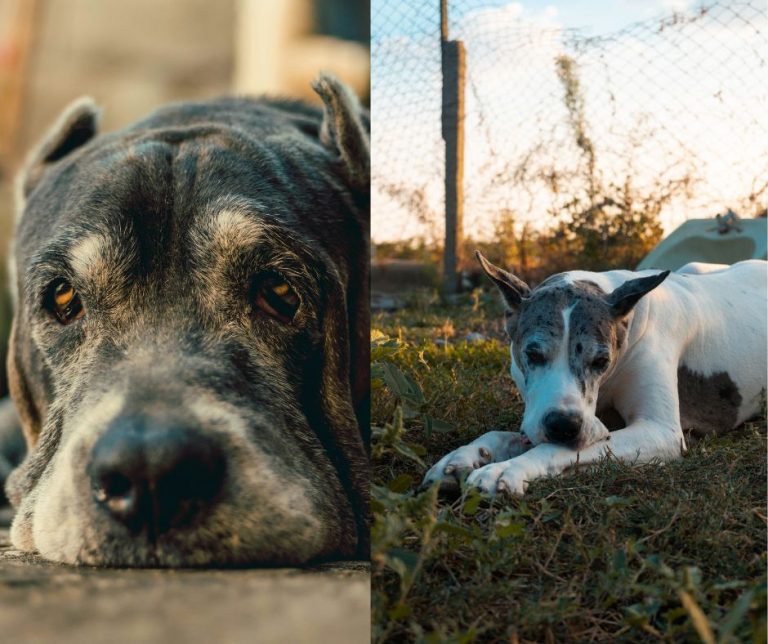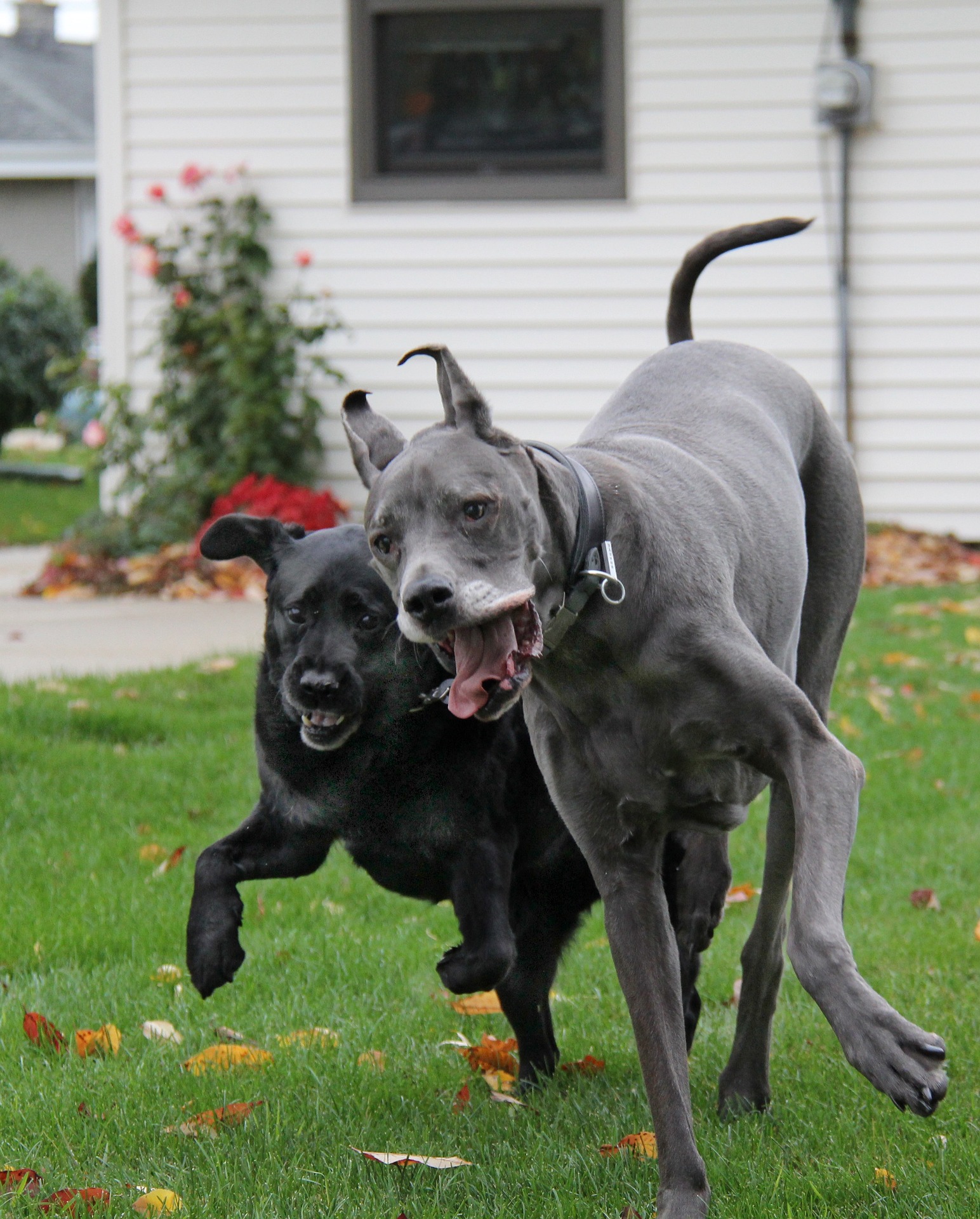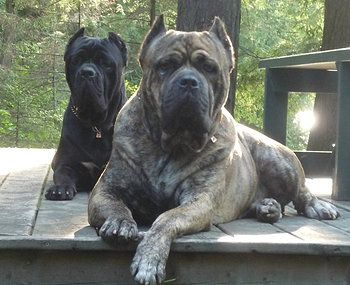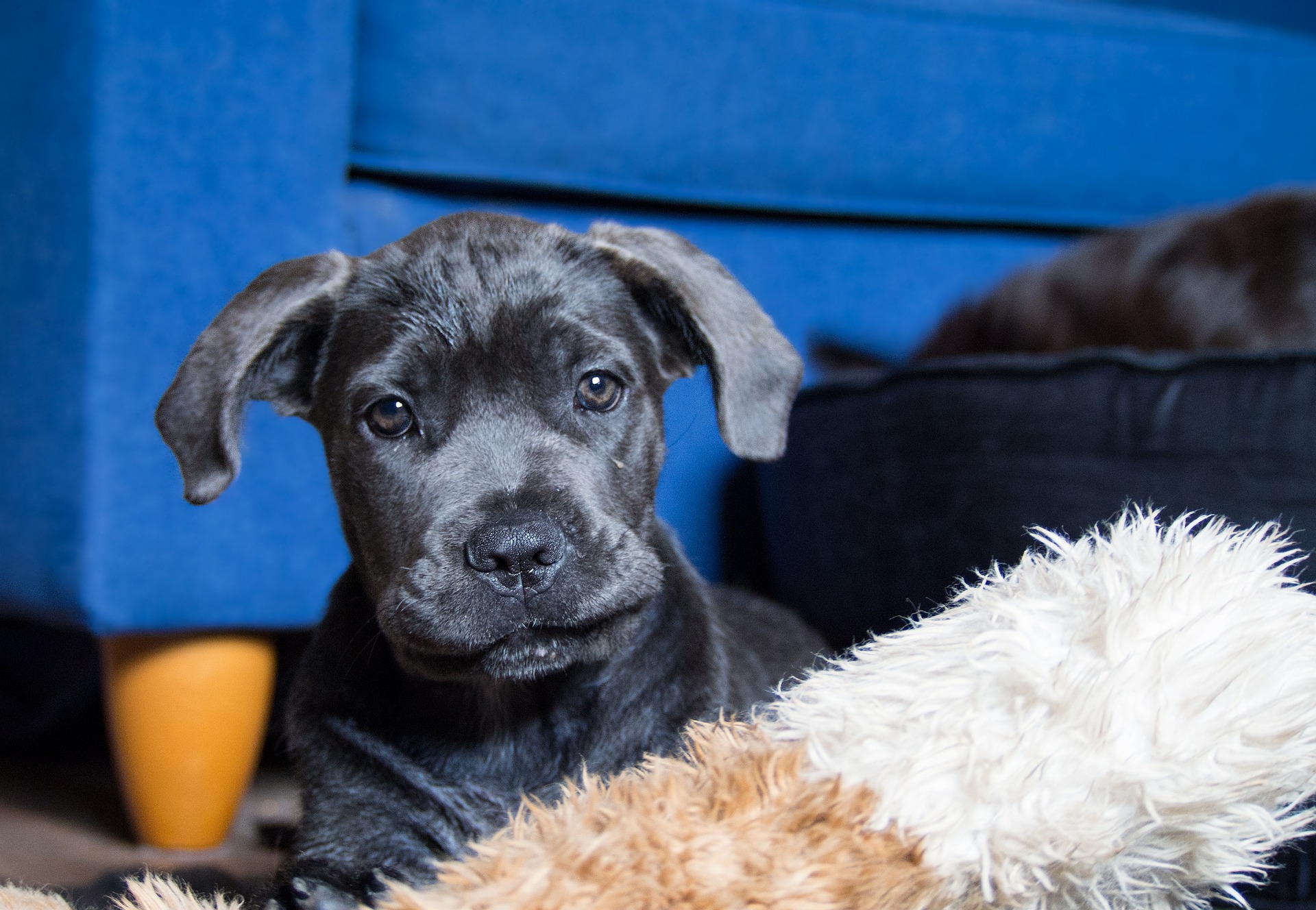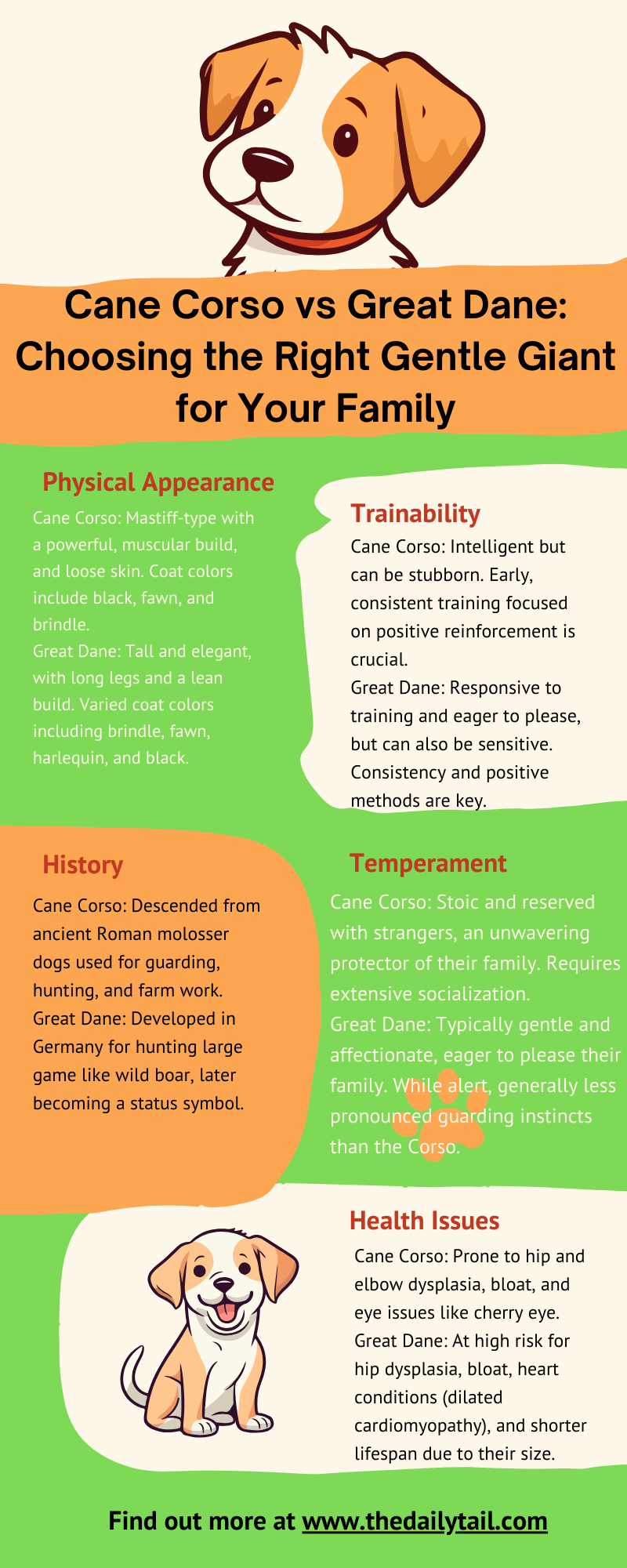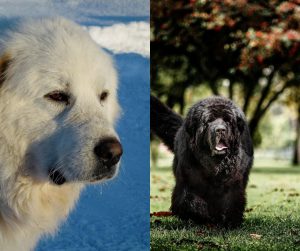They’re both giants, but the Cane Corso and Great Dane bring vastly different energies. I’ve been around for a while, and have lived with dogs for most of my life. And I have taken care of stray dogs and rescue dogs. Let’s explore what lies beyond their impressive statures.
When deciding between a Cane Corso vs Great Dane dog breed, potential dog owners are comparing two giants of the canine world. It’s a choice between two breeds that stand out for their size, but each with distinct histories and characteristics that suit different lifestyles. The Cane Corso’s lineage traces back to ancient Roman war dogs, making them robust and protective, a trait revered by those needing a guardian. On the other hand, the Great Dane’s regal and gentle demeanor, once used to hunt wild boar, now makes them gentle giants perfect for family life.
Understanding the physical and temperamental differences between Cane Corsos and Great Danes is crucial. The former is muscular and agile, often requiring rigorous exercise to match their energy levels, while the latter, despite their larger size, may be more relaxed and content with moderate activities. They both may have impressive statures, but their health needs and lifespans differ, with Great Danes being prone to certain genetic conditions and generally having shorter lifespans compared to Cane Corsos.
Each dog breed’s personality and needs play a significant role in how well they integrate into a household. Cane Corsos might be better suited for individuals or families looking for a loyal and active companion who doubles as a protector. Conversely, Great Danes often fit well with families seeking a more laid-back but affectionate member. The right choice depends on one’s living situation, time commitment, and what they’re looking for in a four-legged friend.
Key Takeaways
- Each breed’s distinctive history shapes its modern temperament and suitability as a pet
- Considering exercise needs and health implications is crucial in the decision process
- Cane Corsos and Great Danes offer different benefits, fitting various family dynamics and lifestyles
Breed History and Origin
Exploring the lineage of dog breeds not only satisfies one’s curiosity but often provides insight into their characteristics and needs. Let’s take a look at the historical tapestries of both the Cane Corso and the Great Dane.
Cane Corso History
The Cane Corso, also known as the Italian Mastiff, has a lineage that can be traced back to ancient Italy. These sturdy dogs were originally bred as working dogs, destined to guard property and assist in hunting large game. The breed nearly faced extinction but was thankfully revived thanks to the efforts of dedicated breeders in the 20th century. Their history is steeped in resilience and versatility, traits that make them as loyal and robust as their ancestors.
Great Dane History
Originating from Germany, the Great Dane boasts an equally impressive heritage. Unlike the Cane Corso’s more utilitarian roots, the Great Dane’s size and strength were initially honed for hunting wild boar. Over time, they transformed from wild hunters to noble estate protectors and, eventually, gentle companions. Their commanding presence paired with their friendly disposition has written them into history as both imposing guardians and affectionate family members.
Physical Characteristics and Appearance
When comparing the Cane Corso and Great Dane, they are immediately recognizable for their impressive statures and striking appearances. These dogs carry a visual impact that is both elegant and powerful, making them notable within the large dog category. These standards have been set by the American Kennel Club.
Size Comparison
Cane Corso:
- Height: 24 to 28 inches
- Weight: 90 to 130 pounds
Great Dane:
- Height: Up to 32 inches
- Note: The world record holder, Zeus, stood at 44 inches!
Both dog breeds fall firmly into the large dog classification, but it’s the Great Dane that often towers over the Cane Corso in both height and sometimes weight. Their considerable size means they both command a significant presence wherever they go. It is also worth noting that the gender plays a role. A male Cane Corso will be bigger than a female Cane Corso dog. Same with male Great Danes and a female dog Great Dane.
But when it comes Cane Corso vs Great Dane size comparison, the latter is the tallest dog in the world. We have to keep that in the back of our mind.
Coat and Colors
Cane Corso:
- Coat: Predominantly a short coat
- Colors: Includes black, gray, fawn, and red; with or without brindle or patch patterns
Great Dane:
- Coat: Also boasts a short coat
- Colors: Offers a variety of hues such as fawn, brindle, blue, black, harlequin, and mantle
Neither dog has a double coat, and shedding is generally considered low for both breeds, making grooming a relatively simple task. Their coats showcase each breed’s physical characteristics vividly, with the range of colors serving to accentuate their already distinguished appearance.
They’re not just sizable; they each bring a unique palette of colors that enhance their visual differences and make them so beloved to their owners.
Temperament and Personality
When choosing between a Cane Corso and a Great Dane, understanding their distinct temperaments and personalities is essential. They each bring a unique blend of loyalty, protection, and affection to a family, shaped by their breed’s history and typical traits.
Cane Corso Temperament
The Cane Corso is revered for its protective nature, often serving diligently as a family guardian. This breed is intelligent and loyal to its owners, making it a strong candidate for someone who can invest in consistent training and socialization. Their protective instinct implies a level of responsible aggression when necessary, yet they exhibit patience and affection with their loved ones. The Cane Corso possesses a notable energy level, requiring regular exercise to maintain a balanced temperament.
Great Dane Temperament
In contrast, the Great Dane breed is affectionately known as a “gentle giant,” thanks to its loving and patient demeanor. Great Danes are gentle with children and show a charming blend of affection and mildness, which sits alongside their impressive size and strength. Despite their stature, they are typically less protective than the Cane Corso and exude a more relaxed energy level. These dogs are also intelligent, but their personality is often more easygoing, making them suitable as companions for families and individuals alike.
Exercise and Training Needs
When considering between Cane Corso vs Great Dane, prospective pet owners should understand that both breeds have distinct exercise requirements and training needs. These powerful dog breeds not only crave physical activity to maintain their health but also benefit from structured training to harness their intelligence and strength.
Exercise Requirements
Cane Corso:
- Exercise Needs: Daily activity is crucial, ranging from 30 minutes to 1 hour
- Energy Levels: Tends to be energetic, requiring a blend of physical and mental stimulation
- Strength: As a strong breed, exercise that includes strength training can be beneficial, such as pulling weights or running alongside a bike
Great Dane:
- Exercise Needs: Despite their size, this giant breed often enjoys shorter daily exercise, typically 30 minutes is sufficient
- Energy Levels: They are less energetic than Cane Corsos and often prefer leisurely walks to vigorous exercise
- Strength: While they are large, Great Danes are not as robust as Cane Corsos, and therefore, exercise should be less intense to prevent joint issues
Training Challenges
Cane Corso:
- Trainability: Known for their intelligence, Cane Corsos are highly trainable with consistent effort
- Training Challenges: They can have a stubborn streak, but with positive reinforcement techniques, they learn obedience
- Pet-Friendly: With early socialization, they can be pet-friendly, though their chasing instinct might require extra attention during training sessions
Great Dane:
- Trainability: Great Danes are eager to please and can be trained effectively with patience and positive reinforcement
- Training Challenges: Due to their gentle nature, they may not respond well to harsh training methods; it’s best to keep sessions engaging and reward-based
- Pet-Friendly: Generally good with other pets, especially when proper introductions are made in a controlled environment
Understanding each breed’s exercise and training needs is the key to a happy, well-adjusted companion. While both breeds are powerful, they each possess a unique set of qualities that define their specific requirements for physical activity and behavioral education.
Health and Lifespan
When it comes to our furry friends the Cane Corso and the Great Dane, their health and lifespan are at the forefront of any owner’s mind. These breeds share common health concerns, yet they also have unique issues due to their sizes and genetics.
Common Health Issues
Cane Corso dogs tend to be robust but they are prone to certain health conditions. They can suffer from:
- Hip Dysplasia: A genetic condition where the hip joint doesn’t fit together perfectly, which can lead to arthritis or lameness
- Eye Problems: Including entropion or ectropion, where the eyelids roll inward or outward
- Bloat: Also known as gastric dilation-volvulus (GDV); it can be life-threatening and requires immediate veterinarian attention
In contrast, Great Danes are gentle giants with their own set of health problems. They commonly face:
- Hip Dysplasia: As with the Cane Corso, this is a concern due to their large size
- Bloat: Their deep chests make them more susceptible to this serious condition
- Heart Conditions: Unfortunately, these dogs are known for cardiac issues, which need to be monitored
Preventative Care
The secret to a healthy life for both the Cane Corso and the Great Dane lies in proactive preventative care. Owners can do the following:
- Regular Brushing: Not only does this keep their coats shiny, but it also provides the chance to check for any skin issues
- Weight Management: Keeping an eye on their diet will prevent weight gain, which can exacerbate health problems like hip dysplasia
- Routine Veterinary Check-ups: Regular visits to the veterinarian can catch any health issues early, ensuring they live a full life within the expected lifespan of 9 to 12 years for the Cane Corso and 7 to 10 years for the Great Dane
It’s clear that while these breeds may face their own challenges, with the right care, they can lead happy and healthy lives.
Suitability as Family Pets
Selecting a large dog breed for a family environment requires careful consideration of the breed’s interaction with children and lifestyle compatibility. Both the Cane Corso and the Great Dane can fit into family settings but have distinct needs and characteristics that should be matched with the family’s way of life.
Interaction with Children and Other Pets
Cane Corsos are known to be protective and loyal companions that tend to form a strong bond with family members. When it comes to children, they can be affectionate and gentle, but they do require socialization from a young age to ensure they can coexist peacefully with youngsters and other pets. Thanks to their protective nature, they often make vigilant guardians for kids.
In contrast, Great Dane dogs are famously friendly giants; they are typically patient and good-natured with kids. This breed, with its lower energy level compared to the Cane Corso, often pairs well with a more relaxed family setting. Due to their sheer size, though, supervision with small children is a must to prevent accidental knocks or tumbles.
- Cane Corso: requires early socialization, generally family-friendly
- Great Dane: naturally gentle, better suited to families with slightly older children
Lifestyle Considerations
Families must also weigh in lifestyle factors when choosing between these two breeds. Cane Corsos have a higher exercise need and thrive in environments where they can expend their energy with purpose—think engaging play or obedience training. Apartment living isn’t ideal for this active breed without ample opportunities for exercise.
The Great Dane, while also a large dog breed, has a more laid-back demeanor, making it adaptable to various living situations, including apartments. However, due to their size, indoor space should be ample enough to accommodate their large frames comfortably. Regular walks and playtime suit their energy levels and keep them content. Their affectionate nature makes them wonderful indoor companions for the whole family.
- Cane Corso: high energy, requires space and exercise, not ideal for apartment living
- Great Dane: adaptable energy, suitable for apartments with sufficient space, affectionate indoor companion
Care and Maintenance
When it comes to bringing out the best in a Cane Corso or Great Dane, they both need a committed caretaker. They’ll require regular grooming and a well-thought-out diet to stay healthy and happy.
Grooming Needs
Cane Corsos have a short coat that makes grooming a bit easier. These coats should be brushed weekly to minimize shedding and maintain skin health. Additionally, they don’t usually have a double coat, which means they are not very high maintenance seasonally. Despite their low grooming requirements, their nails should be trimmed regularly, and it’s wise to keep their ears clean to prevent infections.
For Great Danes, grooming is similar due to their also having a short coat. They do shed, so regular brushing will help keep loose hair under control. They might not be huge fans of bath time, but they’ll need occasional baths to keep them clean and smelling fresh.
Dietary Requirements
Cane Corsos and Great Danes differ not only in size but also in appetite. The diet prescribed for each breed must cater to their specific energy levels and risk of weight gain.
- Cane Corso:
- Daily calories: Approx. 1,500 to 2,200 (adult)
- Protein-rich diet recommended
- Portion control important to avoid obesity
- Great Dane:
- Daily calories: Approx. 2,500 to 3,000 (adult)
- Balanced diet with controlled growth formulas to prevent bone and joint problems due to rapid growth
- Multiple small meals preferred over one large meal to reduce the risk of bloat
In essence, caring for these gentle giants means giving their grooming the attention it deserves and monitoring their diet to match their towering figures and robust energy. Health always lies in the details, so staying on top of these aspects will ensure these dogs thrive under your care.
Breeding and Mixes
These two giant breed dogs have a fair share of potential health risks. That is why a lot of breeders have tried mixing them with healthier dogs.
Now, there is no guarantee that these mixes will turn out to be healthier dogs. But considering a Great Dane lives between 6 and 8 years, it is worth the risk for some pet parents. You still get the charming personality of Great Dane dogs, but with a healthier pup.

